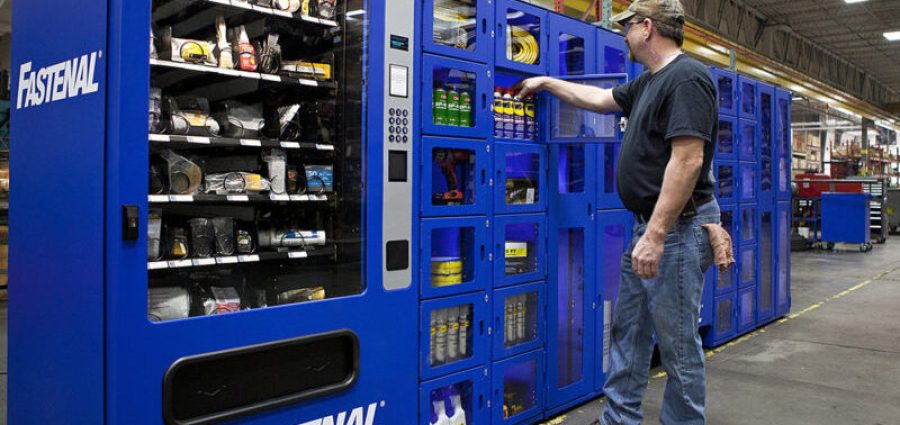Not long ago, the B2B distribution business presented a fairly simple equation: The more calls your skilled account managers could make on customers, the more those customers would buy. You built your sales process on this foundation of face-to-face interactions. You won by having the best team, with the right inventory in branches near the customer, to ensure delivery excellence. In my last blog, I wrote about how the relationship drivers that are valued by B2B buyers are changing. Fastenal’s latest quarterly report shows they are continuing to adjust their customer coverage plans to meet these new expectations.
Also see: “Why Distributors Are Revamping Their Sales Coverage Plans.”
Fastenal is one of the most successful North American distribution success stories in the past 30-plus years. As a branch-based B2B distributor, one of the key drivers of Fastenal’s growth strategy was to open branches in cities and small towns and put inventory and support close to the customer. In many markets, they might have been the only B2B industrial or construction distributor in the city.
By 2013, their branches had expanded to a company peak of 2,687. As you can see from the below key relationship drivers in 2013, it was a winning strategy for the time.

Then, the digital revolution started changing what B2B distribution customers view as the key drivers of the relationship.

Today, customers are moving from human interactions to digital interactions and calls that they make on you. The influence of ecommerce, websites and digital interactions has skyrocketed. The human-to-human influence of branches and the account manager is declining, and what customers value about what you do is changing.
Key Fastenal Adjustments Since 2013
With branch influence on the customer relationship declining, it appears that Fastenal is adjusting. The company now has 2,114 branches as of the end of 2019 — a decline of 523 in the past six years.
E-commerce, website and digital solutions are gaining traction for B2B customers. In response, Fastenal has adjusted and doubled down on its onsite vending machines, and ecommerce capabilities.
Fastenal has continued to invest in vending solutions, reporting, “Our installed device count on Dec. 31, 2019 was 89,937 — an increase of 10.8% over Dec. 31, 2018.” This investment in plant-floor vending solutions that create digital POs and replenishment orders is a key differentiator for Fastenal.
They are also investing in point-and-click ecommerce, reporting, “Ecommerce: sales were +25% 4Q19 vs 4Q18. For full year 2019, e-commerce sales were plus 32%, including plus 35% with our national accounts.”
Fastenal also appears to be maximizing its human resources by redeploying them strategically. Fastenal reports, “We signed 362 new Onsite locations (defined as dedicated sales and service provided from within, or in close proximity to, the customer’s facility) during 2019 and 79 new Onsite locations during the fourth quarter of 2019. We had 1,114 active sites on Dec. 31, 2019, which represented an increase of 24.6% from Dec. 31, 2018.”
These appear to be sound business adjustments from one of the largest B2B distributors to add value to their primarily branch-based business. Fastenal is, at its core, a branch based-distributor, but they are adjusting their model to deal with their changing customer demands.
A decade ago, if you read a distributor closed more than 500 branch locations in five years, you would probably say it was in deep trouble. Fastenal’s sales have grown from $3.9 billion at the end of 2015 to $5.33 billion in 2019. That sales performance, my friends, is far from troubling.
What Can You Learn from Fastenal?
- Understand what your customer needs through research, analytics and feedback. You are probably getting daily direct customer feedback from your employees, but top distributors are using their digital channels, surveys and analytics to augment that direct feedback. If you aren’t using analytics, your website and surveys to get direct customer feedback on what they value, then you are fighting with one hand tied behind your back.
- Make adjustments for your business and understand your channel. If you are a construction-focused distributor who services contractors providing HVAC, electrical, building products and more, your adjustments will be different from an industrial distributor providing MRO or OEM solutions.
Construction B2B distribution will continue to rely on a branch network, as having immediate inventory/delivery for a local jobsite is crucial to competing in this sector. Construction distribution is being affected, but they have more time to react and unique solutions to deploy.
Industrial/MRO distribution’s branch-based solutions, in contrast, are more heavily impacted by the digital revolution. In many cases, you don’t need inventory next to the industrial customer today.
However, in both industrial/MRO and construction distribution, your customers are going to demand more digital versus human interactions over time.
Learn from Other B2B Distributors and Manufacturers
The Fastenal example is just one instance of a distributor making adjustments to a strategy that hadn’t changed much for decades prior.
Our 4th annual MDM Sales GPS conference this May is about more than just theories and research, it’s about seeing what others are doing to attack these opportunities. It’s a great place to see real B2B distributor case studies on their customer coverage plans, and network with other distributors and manufacturers who are making decisions on how to improve their business.
For more information on MDM’s Sales GPS, go to salesgps.mdm.com. It would be great to see you in Chicago to learn together about how to grow in 2020.
We welcome your comments, either in the comment area below or you can reach me at john@mdm.com.

John Gunderson is VP analytics & ebusiness at Modern Distribution Management. Prior to joining MDM in 2018, John was a senior leader for 20 years leading sales, marketing, pricing, analytics and ebusiness with companies such as Crescent Electric Supply Company, HD Supply Power Solutions, HD Supply C&I White Cap, Anixter, and EIS-INC a Genuine Parts company.
Related Posts
-
For the full year, Fastenal reported sales of $5.3 billion, up 7.4% compared to 2018.
-
U.S. sales grew 3.1% in January.
-
By region, U.S. sales grew 10% in April.



